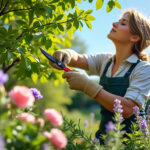Understanding the optimal timing for pruning Viburnum is essential to fostering healthy growth and vibrant blooms. Proper pruning not only shapes the plant but also enhances its overall vitality. This article delves into the best times to prune Viburnum, the tools required for the task, and effective techniques to ensure your plants thrive.
Optimal Pruning Times for Viburnum
Timing is crucial when it comes to pruning Viburnum. The seasons play a significant role in determining the health and flourishing of your plants. Each variety of Viburnum may have its specific needs, but generally, two main periods stand out for pruning activities.
Pruning After Flowering
One of the prime times to prune most Viburnum varieties is immediately after they finish flowering, usually in late spring or early summer. This timing allows the plant to recover and prepare for the next season’s blooms. Pruning at this time is not just practical—it’s strategic, ensuring you won’t cut off the buds that have already begun forming.
- 🌼 Optimal Timing: Late spring to early summer for post-bloom pruning.
- 🔧 Reason: Helps in setting new buds for next season’s flowering.
- 🌱 Outcome: Supports healthy growth and maximizes flower production.
During this period, the plant is energy-rich and can rejuvenate with ease. Focus on removing dead blooms and old or diseased branches to allow better air circulation. This practice minimizes the risk of disease and encourages lush, colorful floral displays in the upcoming season.
Late Winter or Early Spring Pruning
The other ideal window for pruning Viburnum is during late winter or early spring before new growth starts to emerge. This approach is particularly beneficial for those varieties that bloom on old wood, such as the Snowball Viburnum (V. macrocephalum). Pruning at this time is less stressful for the plant, as it is still dormant, allowing it to recover swiftly once the growing season kicks in.
| Season | Action | Rationale |
|---|---|---|
| Late Winter | Hard Pruning | Promotes robust new growth. |
| Early Spring | Light Pruning | Avoids stress before the growing season. |
| Late Spring/Early Summer | Post-bloom Pruning | Maximizes flowering potential for next season. |
Overall, understanding these cycles and schedules for pruning Viburnum allows for a structured approach that promotes healthier plants. Timing is everything; thus, it is crucial to adjust pruning schedules according to the specific variety being cultivated.
The Essential Tools for Pruning Viburnum
Equipping oneself with the right tools is vital for effective pruning of Viburnum. The proper instruments not only simplify the task but also minimize the stress inflicted upon the plants.
Essential Pruning Tools
- 🔪 Bypass Pruners: Ideal for smaller branches. They make clean cuts without crushing the plant tissue.
- 🪚 Loppers: These are perfect for medium-sized branches that require a bit more force to cut through.
- 🛠️ Hand Saw: Best suited for larger limbs that may need significant effort to remove.
- 🧤 Gloves: Essential for hand protection while dealing with thorny varieties or rough branches.
- 👓 Safety Goggles: Protects eyes from debris and accidental injuries during pruning.
Before initiating any pruning, ensure your tools are clean and sharp. Dull tools may cause unnecessary damage to the plant. Regular maintenance of the blades will guarantee cleaner cuts and prevent the spread of diseases among plants.
Preparation Steps Before Pruning
Preparation is key to ensuring that pruning is efficient and effective. Here are some crucial steps to take before beginning:
- 💡 Assess the Plant: Examine the Viburnum to identify dead or diseased branches.
- 📅 Choose the Right Time: Pick a time based on the pruning guidelines discussed above.
- 😷 Disinfect Tools: Always disinfect pruning tools before use to prevent disease transmission.
By ensuring readiness and having the right tools, the pruning process becomes smoother and less intimidating. The aim is to aid the plant in flourishing while minimizing any potential harm.
Effective Pruning Techniques for Healthy Growth
Pruning isn’t just about cutting back branches; it’s an art and a science that focuses on promoting healthy, vigorous plant growth. Each technique serves a specific purpose and contributes toward the overall aesthetics of the plant.
Basic Pruning Techniques
- ✂️ Thinning: This involves removing branches to increase airflow and light penetration, essential for photosynthesis.
- 💁♂️ Deadheading: Cutting off spent flowers encourages the plant to redirect energy toward new blooms.
- 🏗️ Shaping: Modifying the plant’s overall form enhances resilience and beauty.
Thinning can substantially improve the health of Viburnum. It allows less congested growth, which minimizes the likelihood of fungal infections. On the other hand, deadheading after flowering encourages the formation of additional blooms by preventing the plant from exhausting energy on seed production.
Advanced Pruning Techniques
For seasoned gardeners, advanced techniques can help reshape or rejuvenate older Viburnum specimens:
- 💪 Rejuvenation Pruning: This technique involves cutting back the entire plant significantly to stimulate new growth.
- ✨ Canopy Management: Aiming for a well-structured canopy can promote even flowering and prevent bare spots.
- 🏵️ Pollarding: A more radical method that involves cutting back all the established stems to encourage new growth from the base.
Implementing these techniques thoughtfully allows gardeners to maintain the appeal and health of their plants. It’s a balance of ensuring vigorous growth while maintaining the plant’s natural beauty.
Regular Maintenance and Care for Viburnum
Beyond pruning, a holistic approach to maintaining Viburnum health is crucial. Regular care routines enhance resilience and promote vibrant floral displays.
Watering and Fertilizing Tips
Proper hydration is essential for Viburnum. Here are some essential tips:
- 💧 Establish a Watering Schedule: Ensure consistent watering, especially during hot weather.
- 🌱 Fertilizing: A balanced fertilizer boosts nutrient availability. Apply in early spring.
- 💦 Watch for Overwatering: Ensure the soil drains well; soggy roots can lead to root rot.
Regular watering and fertilization contribute to lush foliage and abundant blooms. Timing and technique can significantly affect how well the plant responds. This comprehensive care regime promotes vigorous growth, but always monitor the moisture levels to avoid common pitfalls.
Monitoring Plant Health
Continual observation for signs of pests or diseases is necessary. Here are essential steps gardeners can take:
- 👀 Regularly inspect leaves for unusual spots or discoloration.
- 🐞 Check for pests like aphids or spider mites that could damage the plant.
- 🌿 Remove any dead or diseased foliage promptly to prevent further spread.
Identifying problems early is critical in maintaining plant health. A proactive approach allows for targeted interventions, ensuring that your Viburnum remains robust and vibrant.
When to harvest beetroot for optimal flavor and size
Q&A about Viburnum Pruning
| Question | Answer |
|---|---|
| When is the best time to prune Viburnum? | The ideal time is after flowering in late spring or early summer. |
| Can I prune Viburnum in the fall? | Fall pruning is generally not recommended as it can affect the blooming cycle. |
| What tools should I use for pruning Viburnum? | Bypass pruners, loppers, and hand saws are essential for effective pruning. |
| Will pruning increase blooms in future seasons? | Yes, proper pruning helps focus the plant’s energy on producing new buds. |
| Is it necessary to remove dead branches? | Yes, clearing dead or diseased branches is crucial for plant health. |
With these insights on the best time to prune Viburnum, along with the necessary techniques and tools, gardeners can ensure their plants not only survive but thrive, showcasing their beauty season after season. By adopting these practices, one can foster not just a garden but a flourishing haven of plant life.








